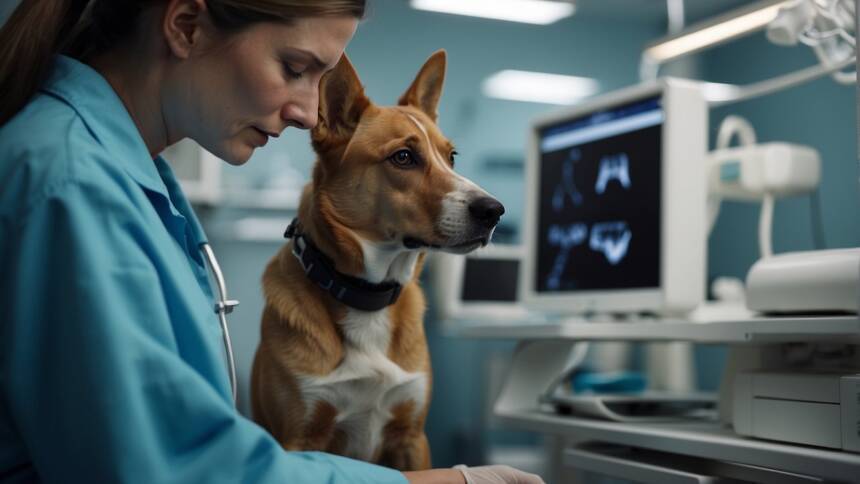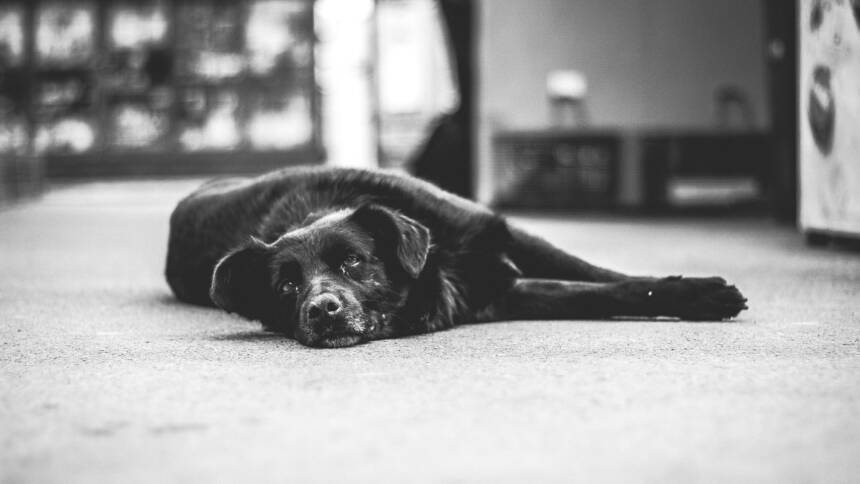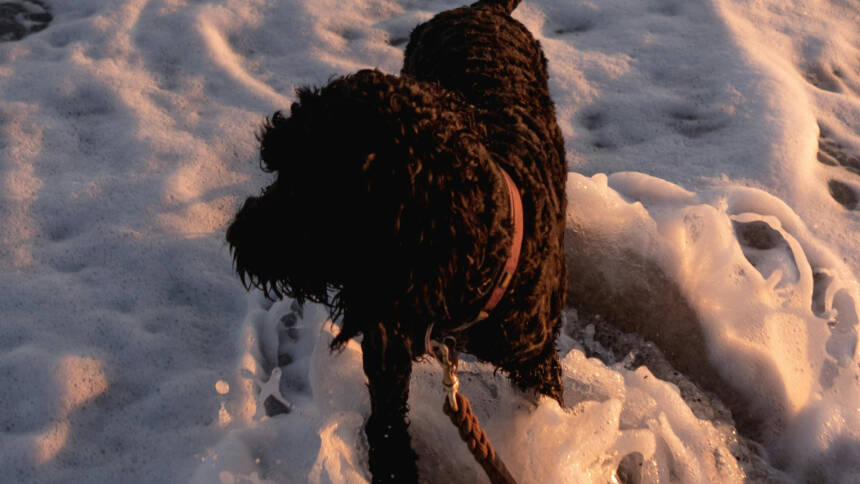Atlantoaxial instability (AAI) is a serious condition in canines that primarily affects the first two cervical vertebrae of the neck—the atlas and axis. These vertebrae play a critical role in providing stability and range of motion to a dog’s head and neck. In cases of AAI, there is abnormal movement between these two bones due to either a congenital defect or trauma, leading to potential spinal cord compression. The condition is seen most commonly in small or toy breed dogs and can lead to significant neurological deficits if not promptly diagnosed and treated.
Diagnosis of canine AAI requires a careful and thorough approach. Clinical signs may include neck pain, reluctance to move the head, abnormal gait, or in severe cases, paralysis. Veterinarians often rely on a combination of detailed clinical examination and advanced imaging techniques to confirm a diagnosis. Radiographs are a primary tool, with indices such as the C1-C2 overlap serving as indicators of the condition. Enhanced imaging with computed tomography (CT) or magnetic resonance imaging (MRI) offers a more detailed evaluation of the vertebrae and surrounding structures, helping to ascertain the extent of the condition and to plan appropriate treatment strategies.
Management of AAI depends on the severity and causation of the instability. In many cases, surgical intervention is recommended to stabilize the vertebrae and alleviate spinal cord compression. Non-surgical management may involve the use of neck braces and restriction of activity, although these methods are typically reserved for milder forms of AAI or when surgery is not an option due to health concerns or other contraindications. Early detection and appropriate intervention are crucial to managing AAI and improving outcomes for affected dogs.
Epidemiology and Pathophysiology
In veterinary neurology, atlantoaxial instability (AAI) is predominantly observed in toy and small breed dogs, with a notable predisposition in certain breeds. The pathophysiology is often rooted in congenital malformations that affect the stability of the atlantoaxial joint, a key support structure of the spine.
Toy and Small Breed Predisposition
Certain breeds, including Chihuahuas, Yorkshire Terriers, and Pomeranians, show a higher incidence of AAI. These toy and small breed dogs are more susceptible to this condition due to genetic predispositions, leading to abnormalities such as hypoplasia (underdevelopment) or aplasia (absence) of the odontoid process, the bony projection of the second cervical vertebra (C2).
Congenital and Acquired Causes
The underpinning cause of AAI can be either congenital or acquired. Congenital cases are often related to birth defects impacting the structure of the atlantoaxial joint, where misshapen or missing elements, like the odontoid process, undermine spinal integrity. Acquired AAI can result from trauma or disease affecting the atlanto-occipital joint, although these instances are less common compared to congenital forms.
Clinical Presentation and Diagnosis
In cases of atlantoaxial instability (AAI) in dogs, clinical signs including neurological dysfunction and neck pain are key indicators, prompting further diagnostic imaging to confirm the condition.
Recognizing Clinical Signs
Clinical signs of AAI may vary in severity, ranging from mild weakness to acute paralysis. Precise observation of a dog’s behavior and symptoms is crucial for an early suspicion of AAI. Neck pain, often evident through a dog’s reluctance to move its head, is a common sign. Neurological assessment may reveal varying degrees of dysfunction, potentially escalating to paralysis. As the condition progresses, affected dogs might exhibit weakness in the limbs or uncoordinated movements, which indicate spinal cord compression.
Diagnostic Imaging Techniques
Diagnostic imaging is indispensable for confirming AAI. Radiography (X-rays) is often the initial imaging technique utilized to assess the structural alignment between the first and second cervical vertebrae. To further evaluate the degree of instability and spinal cord compression, advanced imaging techniques are employed:
- Computed Tomography (CT) provides a detailed cross-sectional view of the bones and allows for precise measurements, identifying even subtle luxations.
- Magnetic Resonance Imaging (MRI) reveals the condition of soft tissues, including intervertebral discs and ligaments, and assesses the extent of spinal cord compression.
Both CT and MRI are powerful tools, enhancing the accuracy of the diagnosis and aiding in surgical planning if required.
Surgical and Non-Surgical Management
In managing atlantoaxial instability (AAI) in dogs, both surgical and non-surgical approaches are available. The chosen method depends on the severity of the condition, symptoms, and overall health of the animal.
Treatment Options
Surgical Treatment: Surgery is often recommended for dogs with significant or progressive neurological deficits due to AAI. Surgical stabilization aims to fuse the atlas and axis to prevent motion and alleviate spinal cord compression. Techniques include dorsal suture fixation, ventral transarticular screw fixation (TSF), or a combination of screws and polymethylmethacrylate cement. Achieving a successful fusion minimizes the potential for future subluxation.
- Ventral Fixation: Ventral fixation surgery is a common procedure in dogs with AAI, showing promising outcomes in stabilizing the cervical vertebrae.
- Dorsal Suture Stabilization: This method involves placing sutures dorsally but is less common due to the evolution of surgical techniques.
Non-Surgical Treatment: Dogs with mild cases, or those deemed unsuitable for surgery, can be managed non-surgically. Treatment may include:
- Strict Rest: Confining the dog to prevent further injury.
- Neck Brace: Use of a neck brace to limit motion and provide support.
- Medications: Use of anti-inflammatory drugs like steroids to reduce spinal cord swelling.
Post-Treatment Care
After surgical or non-surgical treatment, dogs require careful monitoring to ensure proper healing and prevent complications. Post-treatment care includes:
- Activity Restriction: Limiting activity is crucial, especially after surgery, to allow proper bone healing.
- Follow-up Assessments: Regular veterinary check-ups to monitor the success of the treatment and adjust as needed.
- Physical Rehabilitation: After stabilization, rehabilitation may be prescribed to improve neck muscle strength and flexibility.
Anatomical Considerations in AAI Treatment
When addressing atlantoaxial instability (AAI) in dogs, it is crucial to understand the anatomical nuances of the atlas and axis vertebrae. This understanding facilitates safe and effective treatment strategies, including surgical interventions.
Optimal Safe Implantation Corridors
Optimal safe implantation corridors (OSICs) are essential for effective surgical treatment of AAI. OSICs define specific zones within the cervical vertebrae where surgical instruments and implants can safely be placed to stabilize the spine with minimal risk of damaging neural structures. OsiriX™ software aids in identifying these corridors by allowing the visualization of anatomical axes in three dimensions. By analyzing the spatial orientation of these axes, it becomes possible to determine the projA and safa, the anatomical indices critical to OSICs. Utilizing these indices, along with the measurements processed through Microsoft® Excel software, ensures the reproducibility and safety of implant placements.
Challenges of Implant Placement in Small Breeds
In small-breed dogs, the cervical vertebrae, specifically the atlas (C1) and axis (C2), present unique challenges for implant placement due to their size and anatomical variability. The dens, also known as the odontoid process, and the cranial articular surfaces, require careful consideration. Ventral transarticular screw fixation, a recommended stabilization technique, must be adapted to the limited space available in small breeds, where the margin for error is significantly reduced. Surgeons must account for a range of anatomical variations to avoid damage to the spinal cord or vertebral arteries. This makes preoperative planning and the use of advanced imaging techniques critical to successful outcomes.
Complications and Prognosis
Following the diagnosis of Atlantoaxial Instability (AAI) in dogs, the assessment of complications and prognosis is crucial. Potential complications can arise from surgical interventions, while long-term outcomes are influenced by the initial severity of the condition and the success of treatment.
Risks of Surgical Intervention
Surgical treatment of AAI often involves the stabilization of the atlantoaxial joint to reduce spinal cord compression and mitigate symptoms. However, this intervention carries risks:
- Implant failure: The small size of the vertebrae in many affected breeds can lead to complications with the implants used for stabilization.
- Iatrogenic bone fracture: The process of securing implants can inadvertently cause fractures in the delicate cervical vertebrae.
- Vertebral artery injury: Surgery in the cervical spine region carries the risk of damaging the vertebral artery, potentially leading to severe consequences.
- Vertebral canal violation: Improper placement of screws or other stabilization devices may intrude into the vertebral canal, exacerbating spinal cord compression.
- Bone cement leakage: Used to anchor implants, bone cement can sometimes leak, causing further compression or damage.
Long-Term Outcomes
The prognosis for dogs suffering from AAI depends on various factors:
- Trauma and pre-surgery condition: Dogs with less severe trauma and atlantoaxial subluxation may have a better prognosis post-surgery.
- Surgical success: The precise alignment of implants can drastically improve the likelihood of a full recovery.
- Rehabilitation: Postoperative care, including physical rehabilitation, can help in achieving optimal outcomes.
Dogs may experience significant improvement in their quality of life post-surgery, but the condition’s complexity requires careful management to ensure a positive prognosis.
Advanced Diagnostic and Surgical Techniques
Advancements in the field of veterinary medicine have significantly improved the diagnosis and treatment of Atlantoaxial Instability (AAI) in dogs. Cutting-edge imaging tools and innovative surgical procedures now allow for a more accurate assessment and repair of this condition.
Cutting-Edge Imaging Tools
Computed Tomography (CT) Scan: A CT scan is the gold standard for diagnosing AAI in dogs, offering high-resolution images of the atlantoaxial region. Sensitivity and specificity of measurements are crucial, and determining cutoff values for ventral compression index (VCI) can lead to an objective diagnosis. In extension, a VCI ≥ 0.16 and in flexion a VCI ≥ 0.2 is diagnostic for AAI with a sensitivity and specificity of 100% and 94.54% respectively in extension, and 100% and 96.67% respectively in flexion.
Magnetic Resonance Imaging (MRI): MRI complements CT scan by providing detailed soft tissue contrast, which is instrumental in assessing spinal cord integrity and the presence of any cord compression.
Digital Imaging and Communication in Medicine (DICOM): DICOM standards allow the efficient storage, transmission, and handling of medical images, facilitating the sharing of digital radiographic and CT scan data among veterinary professionals.
Neuronavigation: Integrating DICOM with neuronavigation systems provides real-time guidance during surgery, enhancing the precision of implant placement.
Radiographic Techniques: Flexed radiographic angles can be evaluated using anatomical landmarks on lateral cervical radiographs, improving the interpretability of radiographic findings in dogs with AAI.
Innovations in AAI Surgery
Transarticular Screw Fixation: This has shown promise as a robust technique for the surgical management of AAI. Proper identification of bone corridors via CT has been pivotal for safe and effective screw placement.
Dorsal Cemented Technique: A novel development in the field, the dorsal cemented technique for atlantoaxial stabilization provides an alternative to the ventral approach, potentially reducing the risk of injury to the spinal cord and vascular structures during surgery.
Utilization of Anatomical Landmarks: Surgeons rely on critical anatomical landmarks to guide their procedures and to ensure the safety of the structures surrounding the atlantoaxial joint.
Through these advanced diagnostic and surgical techniques, professionals in veterinary medicine are better equipped than ever to diagnose and treat AAI in dogs with precision and confidence.
Research and Future Directions
This section delves into the empirical evidence currently available and contemplates the trajectory for future study in the realm of Dog-Assisted Interventions (AAI) diagnosis.
Current Studies and Findings
Recent studies have illuminated the potential stress and welfare risks for dogs engaged in AAI, underscoring the need for a nuanced understanding of breed and size implications. Researchers have noted an increase in cortisol levels in dogs post-AAI participation, which could indicate stress. The American College of Veterinary Internal Medicine (ACVIM) and the American College of Veterinary Surgeons (ACVS) may find these results significant when developing best practices for therapy animal welfare.
Considerations for Future Research
Future research should integrate novel techniques for assessing the health and performance impacts of AAI on therapy dogs, with a focus on specificity and sensitivity in diagnostics. Prospective studies may benefit from the precision provided by cadavers in veterinary training, akin to retrospective studies that review past cases for pattern recognition. The incorporation of ‘One Health Approach’ may facilitate the comprehensive examination of zoonosis risks and benefits, potentially influencing the guidance provided by ACVIM and ACVS.








